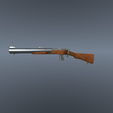I have searched a lot of information online, but I am not sure about its actual length. I have used the size provided by the Firearms Encyclopedia. If you find any errors, please provide me with the information,
The De Lisle carbine or De Lisle Commando carbine was a British firearm used during World War II that was designed with an integrated suppressor. That, combined with its use of subsonic ammunition, made it extremely quiet in action, possibly one of the quietest firearms ever made.[3][page needed]
Few were manufactured as their use was limited to specialist military units.
The weapon was designed as a private venture by William Godfray de Lisle (known as Godfray), an engineer who worked for the Air Ministry.[4] He made the first prototype in .22 calibre; this he tested by shooting rabbits and other small game for the table, near his home on the Berkshire Downs.[5] In 1943, he approached Major Sir Malcolm Campbell of Combined Operations with his prototype; this was informally tested by firing the weapon into the River Thames from the roof of the New Adelphi building in London. This was chosen to discover if people in the street below heard it firing – they did not.[5] Combined Operations officials were impressed with the weapon and requested De Lisle produce a 9mm version. However, this was a failure. A third prototype, using the .45 ACP cartridge that was favoured by de Lisle, was much more successful. Tests of this showed the weapon had acceptable accuracy, produced no visible muzzle flash and was inaudible at a distance of 50 yards (46 m).[2]
Subsequent official firing tests recorded the De Lisle produced 85.5 dB of noise when fired.[6] As a comparison, modern testing on a selection of handguns has shown that they produce 156 to 168 dB when firing without a suppressor, and 117 to 140 dB when firing with one fitted.[7] The De Lisle's quietness was found to be comparable to the British Welrod pistol. However, the Welrod was useful only at very short range and used fabric and rubber components in the suppressor that required replacement after a few shots. The De Lisle was able to fire hundreds of rounds before the suppressor required disassembly for cleaning.[8]
Combined Operations requested a small production run of De Lisle carbines and an initial batch of 17 were hand–made by Ford Dagenham, with Godfray De Lisle himself released from his Air Ministry duties so he could work full-time on the project; this initial batch was immediately put into combat use by the British Commandos.[6] In 1944, the Sterling Armaments Company was given an order for 500 De Lisle carbines, but eventually only produced around 130.[6] The Sterling version differed in a number of details from the earlier, Ford Dagenham model. Two prototypes of a further version, for Airborne forces, were made. These had folding stocks, similar to those fitted to the Sterling submachine gun.[9]
During the remainder of World War II, the De Lisle carbine was mainly used by the Commandos, although they also saw some use by the Special Operations Executive (SOE).[10] E. Michael Burke, the American former commander of a Jedburgh Team, stated that a De Lisle was used by them to assassinate two senior German officers in 1944.[10]
A number of De Lisles were shipped to the Far East and used during the Burma Campaign. The De Lisle would also be used during the Korean War and the Malayan Emergency.[10] It has been claimed the weapon was also used by the Special Air Service during the Northern Irish Troubles.[10]
De Lisle's own .22 prototype was given to the National Army Museum in London, but it was subsequently lost and its present whereabouts are unknown.[8]
I have set them to a 1:35/1:72 ratio for easy printing, and the size comes from the data provided by the encyclopedia. You can adjust its size to any place by yourself.
Note: If using the model for 3D printing, model repairs may be needed.

/https://fbi.cults3d.com/uploaders/27658003/illustration-file/ab07adc1-0afd-4b91-bda5-c9250626e80a/delisle_commando_carbine_-3840x2160.png)





















